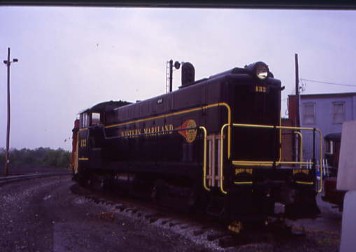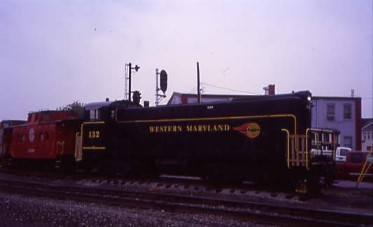
I left the B&O Museum in Baltimore and made my way to Interstate 70 and drove into the incoming storm then stopped at a rest area to get a Maryland state map before driving through the rain to Hagerstown. Once I found the railroad, I asked at a patrol station where the Roundhouse Museum was and was told to go west five lights, turn left, go under the tracks and I would see it. I pulled into the parking lot, grabbed my umbrella and started to explore.
The Hagerstown Roundhouse Museum 5/16/07The Museum is located at 300 South Burhans Boulevard and houses exhibits relating to local railroad history and model railroads. The Hagerstown Roundhouse Complex was built in 1939. The 25 stall roundhouse and shops were the major facility for maintenance and repairs of locomotives and cars in Western Maryland. The railroads were the largest employers in Washington County for more than 50 years. The Roundhouse facility was demolished on March 13, 1999.
The museum was closed on this rainy Wednesday afternoon but I could still look at the outdoor exhibits.


Western Maryland VO-1000 DS-5 132 built by Baldwin in 1944.
Hagerstown and Frederick Transit interurban 168, built by J.G. Brill in 1914. It operated until 1947 and was the last trolley to run in Washington County. It was moved to Dam 5 for use as a cabin then donated to Hagerstown Model Club and moved to a fairground until being donated to the Hagerstown Roundhouse Museum in the 1980's.
Western Maryland caboose 1859 built in 1940. I then made my way back to Interstate 70 to drive to Cumberland, going through one heck of a downpour in which I had to slow to 40 MPH and use my emergency flashers as the windshield wipers could not take the water off fast enough. In addition, there was about four inches of water on the highway. Thank God for some good rock n' roll that took me the rest of the way to Cumberland where I filled the car then drove US 220 south through Keyser to US 50 west to Red House.
There I turned left on US 218 through Elkins, passing through some clouds on the way, and arrived to sunny skies so decided to see what was on Railroad Avenue.
Western Maryland Elkins station built in 1909. The Durbin & Greenbrier Valley Railroad operates historic steam-driven locomotives and classic, diesel-powered vintage passenger trains that depart the historic depots of Elkins, Durbin and Cass between April through December. Trips range from daylong excursions into the Monongahela National Forest to shorter sightseeing trips along the banks of the Greenbrier, Tygarts Valley and Shaver's Fork rivers.
It is also future site of the West Virginia Railroad Museum. From here I drove to the Elkins Motor Inn to get my room for the next two nights.
The Elkins Motor Inn. I drove to Hardee's for the best hamburger I had had at a fast food restaurant. Back at the Inn, the rain started again as I made a few phone calls, watched the History Channel and worked on today's story then called it a night.
4/17/2007 After a pair of doughnuts for a snack, I left the Inn and drove east on US 33 to just short of Riverton, where I turned right on the road leading to Seneca Caverns, arriving there early so I read USA Today while waiting for the office to open.
Seneca Caverns 5/17/2007It started over 460 million years ago. That is when the limestone bed where the Caverns formed was laid under an inland sea. Limestone is formed from the remains of shells from clams, coral and other shellfish, which settle on the bottom of the sea over time.
The first verifiable history of human contact with the cave was in the early 1400's when the Seneca Indians used the cave. The Caverns are located on a great Indian trading route through the Appalachian Mountains. Many tribes used this trading route but it was the Seneca Indians who lived here and used the cave for shelter, storage and special ceremonies. Three hundred years later the first German settlers came to the area. As history goes, a man named Laven Teter rediscovered the cave in 1742 on a quest for water to supply his livestock. At this time the area was not even considered part of the original 13 colonies. The Teter family maintained ownership until 1928. The new owners opened it to the public in 1930 as a show cave.
I walked into the office and bought a ticket along with another couple. Since a large school group had just arrived in two school buses, it was decided to take the three of us on a tour before the others arrived. We put on our miner's helmets and walked out of the back door of the office. Our guide would lead us through Seneca Caverns.
We walked down these stairs and through that door.
The first room was just like a normal cave.
The side profile of Princess Snowbird ... she is the only daughter of Chief Bald Eagle and White Rock of the Seneca Indian Tribe.
The Dutch Bake Oven was much larger, but pieces were removed to make the passageway that we use today.
The Grand Ballroom, second largest room in the Caverns. It is 30 feet wide, 60 feet long and 70 feet high. Legend says that Princess Snowbird was married here in this room and today, weddings are still conducted here.
Still in the Grand Ballroom with stalagmites coming up from the floor and stalactites coming down from the ceiling.
The Leaning Tower of Pisa. It was once a column that was connected to the ceiling but an earthquake a little over 2,000 years ago made part of it fall on the cavern floor.
More flow stone in the Grand Ballroom and in the right hand corner is Jaws from the film "Jaws".
"The Balcony" was next on our unique cave tour.
Bricks to block off a dangerous drop in the cave.
Next the top of the Balancing Rock with an impressive cave roof.
Stalactites were hanging below "The Balcony".
The Bridal Chamber and you could see Princess Snowbird in her wedding dress and her black horse behind it. Behind her is her husband, Rockoak, with his white horse. Below him is the cave's natural totem pole turned upside down.
Next came the Niagara Falls frozen over.
Rock Candy Mountain and you can see different colors of minerals. Brown is iron oxide, blue is magnesium and white is calcium.
Just more flow stone that is located beside Candy Mountain.
We walked by the bottom of the Balancing Rock.
More flow stone beside Candy Mountain.
More flow stone.
A formation that looks like a large turtle.
Next we came to the Hell's Oven.
Unnamed formations.
My tour guide in the red helmet and my new friends in the largest room of the cavern called the Council Room.
Me in Seneca Cave.
Looking back into the Council Room.
Niagara Falls frozen over along with flow stone again.
The ledge that Lavin Teter had to climb over.
Fairyland, the most active part of Seneca Caverns. The stalactites you see are called soda straw stalactites and are made when water drips over them so fast that the centers do not have time to harden.
Fairyland at Christmas.
Fairyland at dawn.
More flow stone and ribbon flow stone formations.
The cowboy's antique shop and the profile of George Washington from his cowboy days.
The cowboy's antique shop and all of the formations are naturally formed but were placed here because they fit so well with the theme. You can see a cowboy hat with the rim shot off, an extra long cowboy boot, an unmarked tombstone and the cowboy buried upside down without his boots on.
There are various cacti.
The United States.
The Great Wall of China.
The rim stone which people like to call "The Winding Roads of West Virginia".
Stalactites were hanging from the ceiling.
The Prison.
Mirror Lake.
Lake Wigwong with two teepees.
New York City upside down.
Princess Snowbird sitting on a log enjoying her view.
Stalagmites.
This column is called Castle on the Rhine.
A column named Jack and the Beanstalk. You can see his mother praying for his safe return and his mean little sister praying he will never return. It is estimated to be 7 to 10 million years old.
More unnamed stalagmites.
The Great Iceberg is a flow stone with a column located estimated to be 50 million years old.
Then we came to the Cave Monster.
A look back at the Cave Monster and Great Iceberg.
Sammy the Salmon swimming up stream.
We came to Sammy the Salmon swimming upstream and the Sandy Hills of South Dakota. With that last picture, we returned up some stairs and back to daylight on the surface. I thanked my guide for the excellent tour then visited the gift shop for some postcards before departing after a fantastic adventure inside this unique cave. A special thank you to Autumn Nelson for all the help with identifying the cave formations. Thank you Autumn!
I drove back to US 33, stopping at the Riverton post office for some stamps then pulled off the highway at Seneca Rock.
Seneca Rock. Since this was the only activity of the day, I drove back to Elkins, filled the car and went to the post office, stopped at Wing Thing for some teriyaki wings for lunch then watched television all afternoon including a documentary called "Thrills" dealing with passenger car safety. At 5:00 PM, I went to the Dining Room at the 1863 Tavern at the Elkins Motor Inn for dinner and ordered the Special, an eight-ounce steak then watched television before calling it a night.
| RETURN TO THE MAIN PAGE |